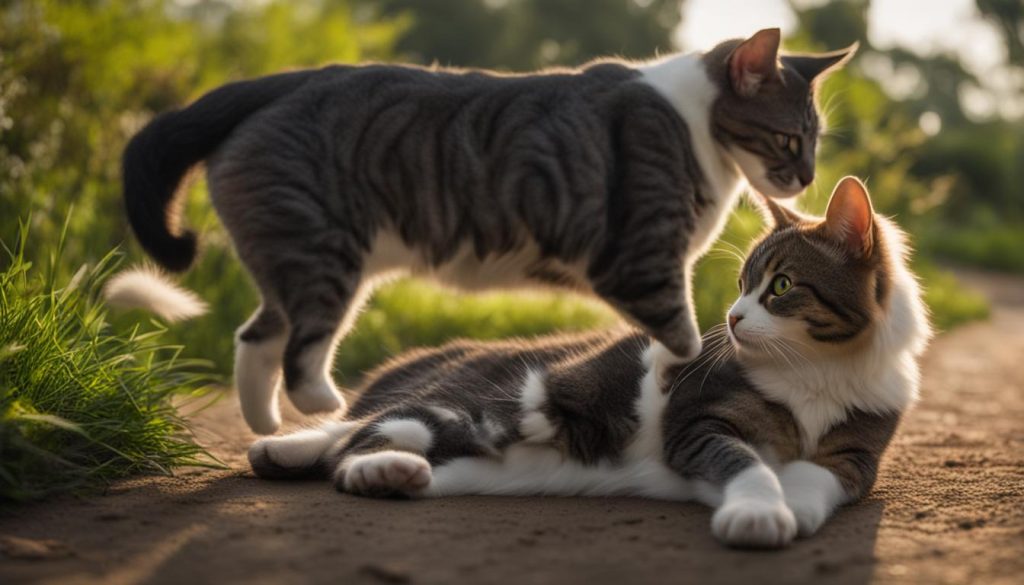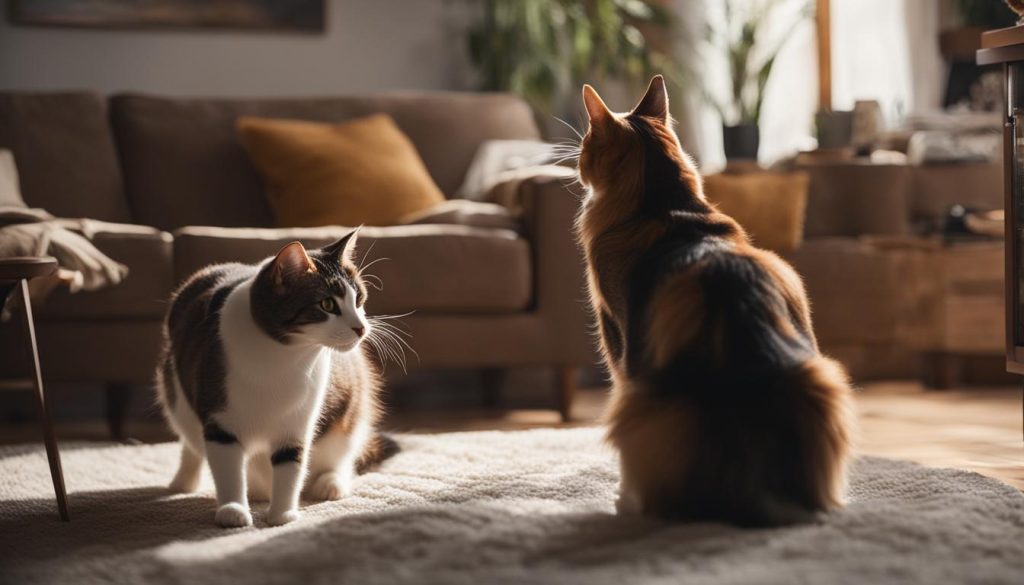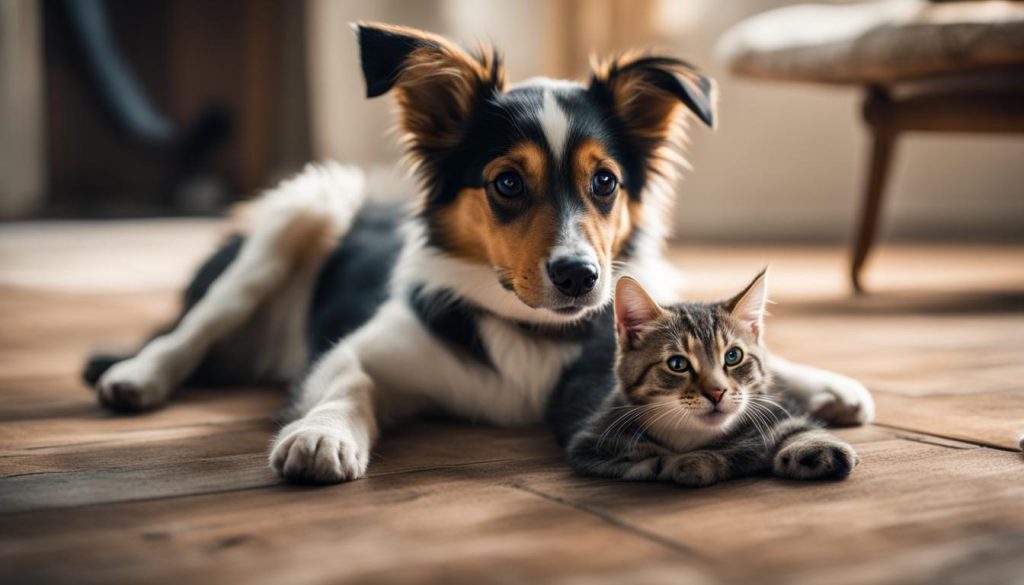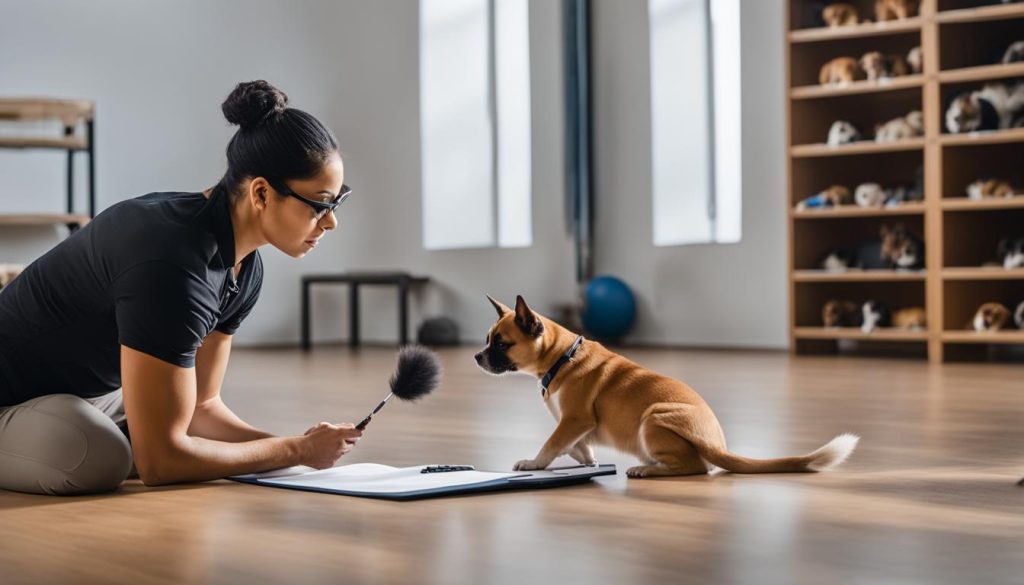Welcome to my comprehensive guide on how to successfully teach your dog to get along with your cat. Building a harmonious relationship between these two pets requires patience, understanding, and proper training techniques. Whether you are introducing a new dog to your cat or working on improving their existing relationship, this guide will provide you with step-by-step instructions to ensure a peaceful coexistence.
Training your dog to get along with your cat is essential for their safety and well-being. Not all dogs have a natural affinity for cats, and some may need more guidance and socialization to develop a positive relationship. By following the techniques outlined in this guide, you can create a safe and positive environment for both your dog and cat, leading to a lasting bond.
Key Takeaways:
- Proper training and introduction are crucial for a peaceful dog and cat relationship.
- Understanding the behaviors and instincts of dogs and cats is essential during the introduction process.
- Creating a safe space and building positive associations can help ease the introduction.
- Gradual introductions and controlled interactions are key to ensuring a smooth transition.
- Training your dog to stay calm around your cat is important for long-term coexistence.
Understanding Dog and Cat Behavior
When introducing a dog and a cat, understanding their behavior is crucial for a successful integration. Dogs and cats have different instincts and behaviors, which can influence how they interact with each other. Dogs, for example, may have a prey drive, which can make them want to chase small animals like cats. This instinct can be a major obstacle when trying to establish a peaceful coexistence between the two.
During the introduction process, closely observe the body language of both animals. Signs of aggression or fear should be taken seriously and addressed appropriately. It’s also essential to remember that each animal is unique, with their own past experiences and temperament. These factors can significantly impact their ability to get along with each other.
In addition to understanding their behavior, I would advise that you create a safe and positive environment for both pets during the introduction process. This includes providing separate spaces for each pet, ensuring they have their own designated areas. By giving them their own space, you can help reduce any potential feelings of territoriality or competition.

Common Dog and Cat Behaviors
Here are some common behaviors exhibited by dogs and cats:
- Dogs may have a prey drive, making them want to chase small animals.
- Cats have a natural instinct to be cautious around unfamiliar animals.
- Dogs may exhibit territorial behavior, especially if they perceive the cat as a threat to their space.
- Cats tend to be more independent and may need time to adjust to the presence of a new dog.
Important Dog and Cat Behavior Cues
When introducing a dog and a cat, pay close attention to their behavior cues. These cues can provide valuable insight into their comfort levels and help you determine the appropriate next steps:
- Tail position: A relaxed wagging tail (for dogs) or a calm, straight tail (for cats) indicates a positive and comfortable state.
- Ear position: Erect and forward-facing ears (for dogs) or relaxed and pointed forward ears (for cats) indicate curiosity and interest.
- Body posture: Relaxed, loose body posture with no signs of tension or aggression is a good indication of comfort.
- Eye contact: Soft, relaxed eye contact indicates trust and comfort.
| Behavior | Dog | Cat |
|---|---|---|
| Prey Drive | May have a high prey drive, making them more likely to chase small animals. | May instinctively be cautious around unfamiliar animals. |
| Territorial Behavior | May exhibit territorial behavior, especially if they perceive the cat as a threat to their space. | May need time to adjust to the presence of a new dog and establish boundaries. |
| Independence | May be more dependent on their owners and seek constant attention. | Tend to be more independent and may need time to warm up to a new dog. |
By understanding the behavior of dogs and cats, you can better navigate the introduction process and ensure the safety and well-being of both pets.
Preparing for the Introduction
Before allowing your dog and cat to interact, please prepare for a successful introduction. Creating a safe and comfortable space for each pet is essential to ensure a positive experience. Here are some steps to follow:
- Keep the pets separate: Keep your dog and cat in separate areas for the first few days. This allows them to get used to each other’s presence without direct contact.
- Designated areas: Provide each pet with their own designated area, complete with their bed, toys, and food and water bowls. This gives them a sense of ownership and security.
- Introduce scents: Swap bedding or towels between your dog and cat’s areas to help them become familiar with each other’s scent. This can be done by placing the items in their respective areas.
- Feeding on opposite sides: Place their food bowls on opposite sides of a closed door. This helps them associate the presence of the other pet with something positive, like mealtime.
By following these steps, you’re setting the stage for a successful introduction between your dog and cat. Try to be patient and give them time to adjust to each other’s presence before moving on to the next step.

Creating a Safe Space
Creating a safe space for your dog and cat is crucial to their overall well-being and the success of their relationship. Here are some tips:
- Provide vertical space: Cats feel safe when they can climb and observe their surroundings. Install cat trees or shelves to give your cat vertical space.
- Secure hiding spots: Cats need hiding spots where they can retreat and feel safe. Provide covered beds or boxes for your cat to use as hiding spots.
- Secure boundaries: Use baby gates or screens to create physical boundaries between your dog and cat’s areas. This allows them to see and smell each other without direct contact.
- Supervise interactions: Always supervise interactions between your dog and cat, especially during the early stages. This ensures their safety and allows you to intervene if necessary.
By creating a safe space, you’re providing your dog and cat with the necessary resources and boundaries to coexist peacefully.
Building Positive Associations
Building positive associations between your dog and cat is essential to foster a harmonious relationship. Here are some ways to do it:
“A positive association can help your pets see each other as friends rather than threats.”
- Treats and rewards: Reward both your dog and cat with treats and praise for calm and positive behavior during interactions or when they are in close proximity to each other.
- Playtime together: Engage both your dog and cat in interactive play sessions together. Use toys that they can enjoy together, promoting a sense of fun and togetherness.
- Positive reinforcement: Use positive reinforcement techniques to reward good behavior from both your dog and cat. This reinforces their understanding that positive behavior leads to rewards.
By building positive associations, you’re creating a foundation for a friendly and cooperative relationship between your dog and cat.
| Dog | Cat |
|---|---|
| Keep on a leash during initial interactions | Allow the cat to approach at their own pace |
| Use treats and praise for calm behavior | Provide treats and rewards for positive interaction |
| Monitor body language for signs of stress or aggression | Observe body language for signs of fear or discomfort |
| Give your dog breaks from interactions | Allow your cat to have their own space and time away from the dog |
Don’t forget that each pet is unique, and the introduction process may vary. Be patient, stay positive, and monitor their interactions closely to ensure a smooth transition.
Gradual Introductions
Once the pets have had time to adjust to each other’s scent, it’s time to proceed with face-to-face introductions. This step is crucial in helping them become familiar with each other’s presence and start building a positive relationship. However, ensure that these interactions are controlled to prevent any potential conflicts.
You can use a baby gate or a screen door to create a physical barrier between your dog and cat during the initial face-to-face introductions. This allows them to see each other and get used to each other’s presence without any risk of harm. You should also closely observe their body language during these interactions to ensure they are comfortable and not showing signs of aggression or fear.
During the controlled interactions, provide positive reinforcement to both pets for their calm and appropriate behavior. This can be done by offering treats and praise whenever they exhibit positive interactions such as sniffing each other without any aggression. By rewarding them for their positive behavior, you are reinforcing the idea that being around each other is a positive and rewarding experience.
It’s recommended to have multiple controlled interactions over a period of at least a week. Gradually increase the duration of these interactions as both pets become more comfortable and responsive. the speed at which they progress will vary depending on their individual personalities and past experiences. Patience and consistency are key during this crucial phase of the introduction process.

Benefits of Controlled Interactions
By implementing controlled interactions, you are giving your dog and cat the opportunity to establish boundaries and learn how to coexist peacefully. These interactions help in building trust and familiarity, allowing them to develop a positive relationship over time.
“Controlled interactions provide a safe environment for your pets to get to know each other, ensuring a smooth and gradual introduction.”
During these interactions, closely monitor their behavior and intervene if necessary. If you notice any signs of aggression, fear, or discomfort, it’s best to separate them and seek professional advice if needed. To put it simply, every pet is unique, and the introduction process may take longer for some than others.
It’s crucial not to rush the process and let your pets dictate the pace. With patience, consistency, and positive reinforcement, you can help your dog and cat build a strong foundation for a harmonious coexistence.
Training Your Dog to Stay Calm
When introducing your dog to a cat, train them to stay calm and exhibit appropriate behavior. This can help create a positive and safe environment for both pets. Training your dog to stay calm can be achieved through consistent practice and positive reinforcement.
Start by teaching your dog basic obedience commands such as sit, lie down, and stay. These commands can help redirect your dog’s attention and keep them calm in the presence of a cat. Use treats and praise to reward your dog for staying calm and following the commands.
Gradually increase the difficulty of the training exercises by introducing distractions, such as having the cat in the same room but at a distance. Reward your dog for remaining calm and focused on you. With consistent training, your dog will learn to associate the presence of the cat with positive experiences and rewards.
Training Tips for Calm Behavior:
- Use positive reinforcement techniques, such as treats and praise, to reward your dog for calm behavior.
- Keep training sessions short and frequent to maintain your dog’s focus and attention.
- Avoid punishment or harsh corrections, as this can create fear or anxiety in your dog.
- Provide mental and physical stimulation for your dog through interactive toys and regular exercise.
- Consistency is key – establish clear rules and boundaries for your dog’s behavior around the cat.
To put it simply, training your dog to stay calm around a cat is a gradual process. Stay patient and consistent in your training efforts. With time, your dog will learn to coexist peacefully with your cat.

| Training Tip | Description |
|---|---|
| Positive Reinforcement | Reward your dog with treats and praise for calm behavior. |
| Short Training Sessions | Keep training sessions brief to maintain your dog’s focus and attention. |
| Avoid Harsh Corrections | Avoid punishment or harsh corrections, as it can create fear or anxiety. |
| Mental and Physical Stimulation | Provide interactive toys and regular exercise to keep your dog mentally and physically stimulated. |
| Consistency | Establish clear rules and boundaries for your dog’s behavior around the cat. |
Long-Term Friendship Between Dogs and Cats
Once your dog and cat have successfully gone through the introduction process and can coexist in the same space, you should continue supervising their interactions to ensure their safety and maintain a positive relationship. While they may become friends, please remember that each animal has its own personality and preferences, and true friendship is not guaranteed. Here are some tips for fostering a long-term friendship between your dog and cat:
- Create opportunities for safe interactions: Allow your dog and cat to spend time together in a controlled environment. Keep an eye on their body language and intervene if any signs of aggression or discomfort arise. I recommend that you gradually increase their time together to help them get accustomed to each other’s presence.
- Provide individual space and resources: Make sure each pet has their own designated space where they can retreat to when needed. This can be a separate room, a crate, or a high shelf for the cat. Additionally, ensure that both pets have their own food bowls, water bowls, and litter boxes to avoid any potential conflicts.
- Praise and reward positive interactions: Whenever your dog and cat engage in calm and friendly behavior, praise and reward them with treats or words of encouragement. Positive reinforcement is key to reinforcing good behavior and strengthening their bond.
To put it simply, even though your dog and cat may develop a close bond, it is good practice to continue supervising their interactions, especially during the initial phases of their friendship. This will help you identify and address any potential issues or conflicts before they escalate. With patience, consistency, and continued supervision, your dog and cat can enjoy a harmonious and long-lasting friendship.

Introducing Kittens and Puppies
Introducing a new kitten to a dog or a puppy to a cat can be an exciting but delicate process. I recommend that you take extra caution and manage their interactions to ensure a smooth transition. Close supervision is necessary, especially when introducing a kitten to a dog, as kittens may not have fear of dogs and may provoke them unintentionally.
One effective way to manage interactions is by using baby gates or leashes to create a physical barrier between the two animals. This allows them to see and smell each other without the risk of unwanted chasing or rough play. Gradually increase their exposure to each other over time, monitoring their behavior closely.

Managing Interactions
During the initial introductions, set boundaries and create a calm environment. Provide separate spaces for each pet, with their own food, water, and litter box. This allows them to feel secure and have their own safe haven. Slowly introduce supervised interactions, keeping the sessions short and positive. Reward both the kitten and the dog or puppy for good behavior and calm interactions.
| Introducing a Kitten to a Dog | Introducing a Puppy to a Cat |
|---|---|
| Keep the kitten in a carrier or use a baby gate to create a barrier during initial introductions. | Keep the puppy on a leash to control their movements and prevent them from overwhelming the cat. |
| Allow them to sniff each other and observe their body language. Gradually increase their exposure to each other over time. | Allow the cat to approach the puppy at their own pace. Keep interactions short and positive. |
| Monitor their behavior closely and separate them if signs of aggression or stress occur. | Monitor their behavior closely and provide a safe space for the cat to retreat to if needed. |
Don’t forget that each pet is an individual and may require different lengths of time to adjust to each other. Patience, consistency, and positive reinforcement are key in creating a harmonious relationship between your new kitten and dog or puppy and cat.
Seeking Professional Help
If you’re facing challenges in teaching your dog to get along with your cat, don’t hesitate to seek professional help. A professional dog trainer can provide valuable guidance, behavior assessment, and expert advice to make the introduction process smoother and more successful. They have the knowledge and experience to understand the dynamics between dogs and cats and can tailor a training plan specific to your pets’ needs.
When choosing a professional dog trainer, look for someone who specializes in dog-cat interactions. They should have experience in managing and resolving issues related to introducing dogs to cats. A trainer can assess your dog’s behavior and temperament, identify any potential triggers, and help you understand why certain behaviors may occur.
During the training process, a professional trainer can guide you on how to create a positive environment for both your dog and cat. They can teach you effective training techniques to use with your dog, such as commands for calm behavior and positive reinforcement strategies. With their expert guidance, you can ensure that the introduction process is safe and stress-free for both your pets.

To put it simply, seeking professional help doesn’t mean you’ve failed as a pet owner. It’s a proactive step to ensure the well-being and happiness of both your dog and cat. By working with a professional, you can address any challenges or issues that arise during the training process and pave the way for a harmonious coexistence between your pets.
Final Thoughts
To sum it up, achieving a peaceful coexistence between your dog and cat is possible with the right training and management. By understanding their behaviors and instincts, creating a safe environment, and gradually introducing them, you can help them develop a positive relationship.
Try to use positive training techniques, rewarding calm behavior and providing treats and praise. Consistency and patience are key throughout the process. While not all dogs and cats will become best friends, with proper training and supervision, they can live together peacefully.
If you encounter difficulties or have concerns during the introduction process, don’t hesitate to seek professional help from a dog trainer. They can provide expert guidance, assess behavior, and teach effective techniques that will contribute to a harmonious coexistence between your dog and cat.
FAQ
Can dogs and cats live together peacefully?
Yes, dogs and cats can live together in harmony with proper training and introduction.
Do all dogs naturally get along with cats?
No, some dogs may naturally get along with cats, while others may need more guidance.
Are puppies easier to introduce to cats?
Puppies that are socialized with cats from a young age are more likely to be comfortable around them.
Why is it important to create a safe environment for both pets during the introduction process?
Creating a safe and positive environment helps reduce stress and anxiety for both pets and promotes successful introductions.
What should I do if my dog shows signs of aggression or fear during the introduction?
Signs of aggression or fear should be taken seriously, and it may be necessary to consult a professional dog trainer for guidance.
How should I prepare before allowing my dog and cat to interact?
I recommend that you create a safe space for each pet, keeping them separate initially and gradually introducing their scents and presence to each other.
How can I help my dog and cat get used to each other’s presence?
You can start by placing items that smell like the other pet in their designated areas and feeding them on opposite sides of a closed door.
What is the best way to introduce my dog and cat face-to-face?
Face-to-face introductions should be done with a baby gate or screen door to allow them to see each other without any risk of injury.
How long does the gradual introduction process usually take?
Multiple interactions should be done over a period of at least a week to gradually build up their comfort level with each other.
How can I teach my dog to stay calm around my cat?
Teaching commands like sit, lie down, and stay, and rewarding calm behavior with treats can help your dog associate the presence of the cat with rewards.
Can dogs and cats coexist without supervision?
While some dogs and cats can coexist without supervision, consider the safety of both animals and provide them with their own resources.
How should I introduce a kitten to a dog or a puppy to a cat?
Close supervision is necessary when introducing a kitten to a dog or a puppy to a cat, using baby gates or leashes to manage interactions and prevent rough play.
What should I do if I’m unsure or there are existing issues with the dog and cat introduction?
Seek help from a professional dog trainer who can assess your dog’s behavior, provide guidance on the introduction process, and teach effective training techniques.
Is it possible for dogs and cats to become best friends?
While not all dogs and cats will become best friends, most can live together peacefully with proper training and management.
What is the key to fostering a positive relationship between a dog and cat?
By understanding their behaviors, creating a safe space, and gradually introducing them, you can foster a positive relationship between your dog and cat.
How can I ensure a peaceful and harmonious coexistence between my dog and cat?
Prioritize their safety, continue supervision, and seek professional help if needed to ensure a peaceful and harmonious coexistence between your dog and cat.






